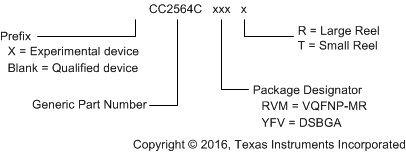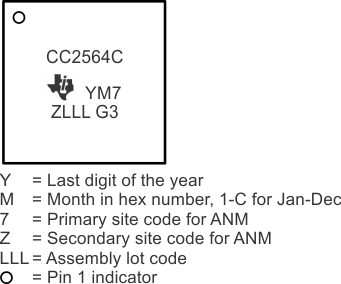ZHCSFX3A April 2016 – November 2016 CC2564C
PRODUCTION DATA.
- 1器件概述
- 2修订历史记录
- 3Device Comparison
- 4Terminal Configuration and Functions
-
5Specifications
- 5.1 Absolute Maximum Ratings
- 5.2 ESD Ratings
- 5.3 Power-On Hours
- 5.4 Recommended Operating Conditions
- 5.5 Power Consumption Summary
- 5.6 Electrical Characteristics
- 5.7 Thermal Resistance Characteristics for VQFN-MR (RVM) Package
- 5.8
Timing and Switching Characteristics
- 5.8.1 Device Power Supply
- 5.8.2 Clock Specifications
- 5.8.3 Peripherals
- 5.8.4
RF Performance
- 5.8.4.1
Bluetooth BR and EDR RF Performance
- 5.8.4.1.1 Bluetooth Receiver—In-Band Signals
- 5.8.4.1.2 Bluetooth Receiver—General Blocking
- 5.8.4.1.3 Bluetooth Transmitter—GFSK
- 5.8.4.1.4 Bluetooth Transmitter—EDR
- 5.8.4.1.5 Bluetooth Modulation—GFSK
- 5.8.4.1.6 Bluetooth Modulation—EDR
- 5.8.4.1.7 Bluetooth Transmitter—Out-of-Band and Spurious Emissions
- 5.8.4.2 Bluetooth low energy RF Performance
- 5.8.4.1
Bluetooth BR and EDR RF Performance
-
6Detailed Description
- 6.1 Overview
- 6.2 Functional Block Diagram
- 6.3 Clock Inputs
- 6.4 Functional Blocks
- 6.5 Bluetooth BR and EDR Features
- 6.6 Bluetooth low energy Description
- 6.7 Bluetooth Transport Layers
- 6.8 Changes from the CC2564B Device to the CC2564C Device
- 7Applications, Implementation, and Layout
- 8器件和文档支持
- 9机械、封装和可订购信息
8 器件和文档支持
8.1 Third-Party Products Disclaimer
TI'S PUBLICATION OF INFORMATION REGARDING THIRD-PARTY PRODUCTS OR SERVICES DOES NOT CONSTITUTE AN ENDORSEMENT REGARDING THE SUITABILITY OF SUCH PRODUCTS OR SERVICES OR A WARRANTY, REPRESENTATION OR ENDORSEMENT OF SUCH PRODUCTS OR SERVICES, EITHER ALONE OR IN COMBINATION WITH ANY TI PRODUCT OR SERVICE.
8.2 工具与软件
设计套件与评估模块
-
CC256x Bluetooth® 硬件评估工具 这款直观的用户友好型 TI 工具用于评估 TI 蓝牙芯片,能够以完整软件包的形式从 TI 网站下载。具体而言,该工具用于通过服务包 (SP) 配置蓝牙芯片属性,同时支持测试 RF 性能。
有关开发支持工具的完整列表,请参见 TI CC256x wiki。有关定价和购买信息,请联系最近的 TI 销售办事处或授权分销商。
8.3 器件命名规则
为了标明产品开发周期的阶段,TI 为所有部件号分配了前缀。这些前缀代表了产品开发的发展阶段,即从工程原型直到完全合格的生产器件。
器件开发进化流程:
-
X 试验器件不一定代表最终器件的电气规范标准并且不可使用生产组装流程。
-
P 原型器件不一定是最终芯片模型并且不一定符合最终电气标准规范。
-
无完全合格的芯片模型的生产版本。
 Figure 8-1 CC2564C 器件命名规则
Figure 8-1 CC2564C 器件命名规则
 Figure 8-2 芯片标记(VQFN-MR 封装)
Figure 8-2 芯片标记(VQFN-MR 封装)
8.4 Community Resources
下列链接提供到 TI 社区资源的连接。 链接的内容由各个分销商“按照原样”提供。 这些内容并不构成 TI 技术规范和标准且不一定反映 TI 的观点;请见 TI 的使用条款。
-
TI E2E™ Online Community The TI engineer-to-engineer (E2E) community was created to foster collaboration among engineers. At e2e.ti.com, you can ask questions, share knowledge, explore ideas and help solve problems with fellow engineers.
-
TI Embedded Processors Wiki Established to help developers get started with Embedded Processors from Texas Instruments and to foster innovation and growth of general knowledge about the hardware and software surrounding these devices.
8.5 商标
E2E is a trademark of Texas Instruments.
ARM7TDMI is a registered trademark of ARM Limited.
由 is a registered trademark of Apple, Inc.
蓝牙 is a registered trademark of Bluetooth SIG, Inc.
All other trademarks are the property of their respective owners.
8.6 静电放电警告

ESD 可能会损坏该集成电路。德州仪器 (TI) 建议通过适当的预防措施处理所有集成电路。如果不遵守正确的处理措施和安装程序 , 可能会损坏集成电路。
ESD 的损坏小至导致微小的性能降级 , 大至整个器件故障。 精密的集成电路可能更容易受到损坏 , 这是因为非常细微的参数更改都可能会导致器件与其发布的规格不相符。
8.7 Glossary
-
TI Glossary This glossary lists and explains terms, acronyms, and definitions.